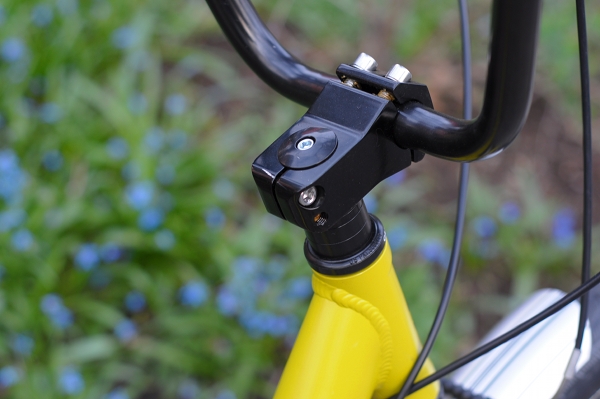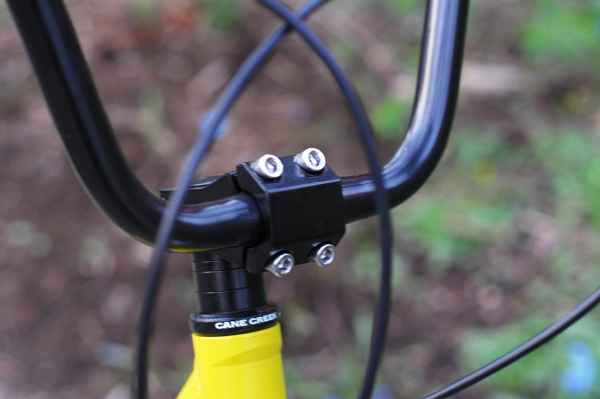With the Urbana bike temporarily in my possession and the Surly bikes we rode last week-end, I have suddenly undergone a crash course in threadless stems. Though of course I have seen them on bikes before, now I got to actually play around with one and understand it firsthand.
In the world of classic and vintage bicycles, you will find a strong preference for threaded (quill) stems, and for good reason: Threadless stems are a fairly recent invention and their thick, boxy shape tends to clash with the more elegant lines of a lugged steel frame. In other words, they are considered "ugly." But I do not necessarily share this sentiment. While it is true that many - probably most - of the threadless stems we see on production bikes are clunky and offensive-looking, it does not have to be that way: Ugliness is not an inherent property of a threadless stem, but a byproduct of modern manufacturers generally catering to an "athletic gear" aesthetic. Elegant, polished alloy threadless stems do exist - made by the likes of Nitto and Velo Orange. Here is a nice fillet-brazed threadless stem and even a lugged one. Threadless stems can also be painted to match the frame of the bicycle, which to my eye actually works better than when the same is attempted with a quill stem. Even the simple, utilitarian stem on the Urbana bike doesn't look at all bad: I think it suits this bicycle's chunky tubing and contemporary style.
Of course the other major criticism of threadless stems is a practical one, and it is one with which I do agree: While quill stems can easily be raised and lowered to adjust handlebar height, threadless stems cannot. When buying a new frame meant for a threadless stem, there is a process (which I only half-understand), whereby you decide on the handlebar height you want, and they cut the steerer tube accordingly, then attach the threadless headset, spacers, and stem. After that, the handlebar height you chose is fixed, and it is not entirely clear to me what the options are, should you change your mind down the road and want the handlebars raised or lowered.
With a pre-assembled bike there is even less choice, because the threadless stem is already installed and the handlebar height is predetermined without your involvement. For me, this system would pose a major problem - especially on a roadbike - as it usually takes me a while to fine tune my preferred handlebar height on any given bike, and even after that I just occasionally feel like a change. With a threadless stem, I would be out of luck. If you are a novice road cyclist, this also makes it impossible to get yourself gradually accustomed to drop bars via the "lowering the stem" method I described earlier.
But while the lack of height adjustability is a drawback, I also discovered an unexpected benefit to the threadless stem: It is easier for me to work on. As mentioned before, I have problems with my hands that, frustratingly, make it mostly impossible for me to work on bikes. I know how to do most of the stuff and can give clear instructions to someone else, but typically lack the hand strength necessary to perform the operations myself. Not so with the Urbana bike. I first noticed that I was able to work on this bicycle, when we were putting it together and I tightened a bolt that I normally wouldn't have been able to. Later, I wanted to change the angle of the handlebars, so I watched this instructional video and did it - loosening and retightening the bolts with no problems. By contrast, I cannot even budge the bolt on a quill stem on my own. If threadless stems are generally easier to work on, then it's nice to have this bit of independence.
What's your view on the benefits or drawbacks of threadless stems? Do you see them as out of the question on classic bicycles?
Wednesday, April 20, 2011
Subscribe to:
Post Comments (Atom)
Blog Archive
-
▼
2011
(631)
-
▼
April
(69)
- Surly Progress and a Couple of Glitches
- Working on Mistress, My Yamaha V-Star 1100 Classic
- 1929 Model Big Four Norton - SOLD
- Weekly Twitter Redux
- PCG Digital Marketing Announces First Ever Passion...
- 1928 Model 24 - For sale
- On Weddings and Bicycles
- Tameron Hyundai Announces Hyundai Taps Power Of Gr...
- Europe doubles the share of renewable energy in a ...
- Long Island Custom Motorcycle paint, custom automo...
- Market Report, "Romania Autos Report Q2 2011", pub...
- Domestic Bike Share
- Norton at the 1914 Isle of Man TT
- When Cyclists Complain About Cyclists
- Find Your Favorite NC Kia Dealer on Facebook
- Roadie Lads and Lasses: Suggestions for Sunglasses?
- Car Recalls for Nissan and Toyota Continue: Steeri...
- 1923 Model 18 cylinder head - For sale
- On Living Locally and Seeking Continuity
- 1928 Model 18 Norton
- Soma's Fab in 650B! A Test Ride of the Buena Vista...
- Selling your Car SwapRide announces partnership wi...
- Popular Demand: Weekly Twitter Redux
- Action Toyota: New Prius Is Coming Soon
- Every Month Is 'Bike Month'
- Don Marshall Auto Announces Return of Minivan Sale
- Peltier Chevrolet Has Over 300 Used Cars for Longv...
- Loaded
- Threadless Stems: the Good, the Bad and the Ugly
- c1924 Model 18 Norton
- Sprint’s New Mobility Solution for a Better Planet...
- The Surly Cross Check: a Worthy Host for 700C Fat ...
- Intrigued by the Pedersen
- Tony's 1930 Model CS1 Norton
- Fast Cages / NASCAR
- Stainless Steel Rainbow Bike
- LED task light enhances visual performance and red...
- UK carbon floor price could weaken British competi...
- That Fateful Click
- Stanley on the 1926 senior TT winning Norton
- Tentec Launches New Bolt Tensioning Tools for Larg...
- Staining Your Grips to Match Your Saddle
- Tameron Hyundai announces Hyundai to Introduce New...
- An important letter from Mrs Woods to Stanley Woods
- Bike Fit: A Case of Evolving Preferences?
- Across America On The Power Of One Lightbulb
- The Unicrown Fork
- Ford’s 3 Latest Industry-Exclusive Technologies ta...
- Orlando FL Dodge shoppers flood Central Florida Ch...
- Model 16H Norton
- Philosophy Panniers: Two Versatile Classics
- New Market Research Report: Australia Autos Report...
- Doubling Down?
- “Civil Warriors” Documentary Will Air on National ...
- Reusable Grocery Bags: Their Contents and Discontents
- Aspect Enterprise Solutions Is Positioned In Gartn...
- Wimmer and KeyMotorsports Ready For O’Reilly Auto ...
- Joe Craig tells of incident between the big races...
- Bicycle Blogs and Social Media
- 1937 Model 40 Manx - For sale
- The Young International Releases New EP
- High-Vis Rainbike, Anyone?
- How Saudi Downstream 2011 Exceeded Expectations!
- Female Anatomy and Saddle Discomfort
- Two Years Older, Not Much Wiser!
- 1937 Model ES2 Norton - For sale
- When Simplicity Trumps Comfort
- Uphill Momentum?
- Satisfied Customers Write Positive Bill Pierre Che...
-
▼
April
(69)



0 comments:
Post a Comment